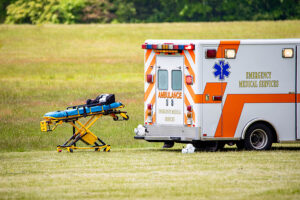
On an unseasonably warm November afternoon, Paramedic Chad Shade and his colleagues with the Alexandria, Virginia Fire Department responded to a call from a sports complex in the southern part of the city. Upon arrival they found a 14-year-old girl whose team was playing in a soccer tournament. An athletic trainer on scene said the girl had complained earlier of some cramping and feeling lightheaded, so they had been trying to hydrate her with oral fluids and she wanted to keep playing. But then the cramps got worse, and when the AFD team arrived the patient was having muscle spasms in all four extremities and hyperventilating. She was barely even responding to her family and medical staff on scene.
The medics could see her muscles twitching and were immediately concerned she might be suffering from severe dehydration. Her initial vital signs reinforced their suspicions, with a systolic blood pressure of 70 mm/Hg and a heart rate hovering around 170. After initiating transport to a pediatric emergency department, they gained IV access with a 20 gauge in her left AC and began infusing normal saline using the LifeFlow Fluid Infuser. In only a few minutes, they had administered a liter of fluid, and her mental status and vital signs had improved.
“Once we were able to do that, it was a night and day difference,” said Shade, himself the father of four young children – including some soccer players. The girl’s mental status improved, and her vitals began to stabilize. That allowed them to also administer some Ativan to help ease the discomfort from the muscle spasms. By the time they transferred care at the hospital, she was feeling better, her blood pressure had increased to 132/81, and her heart rate had decreased.
In hypotensive patients, emergency responders are often forced to use a small gauge IV or an IO for vascular access. In either case, delivering fluids or blood quickly is nearly impossible. Without LifeFlow, Alexandria paramedics say, it might’ve taken the entire transport to the hospital to administer the fluid bolus, leaving this child in pain and in danger of suffering more significant effects of her illness. Instead, she was quickly feeling better, bringing relief to her mother, the medics treating her, and of course to the young woman herself.
Interested in learning more about LifeFlow? Contact us.

